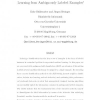Free Online Productivity Tools
i2Speak
i2Symbol
i2OCR
iTex2Img
iWeb2Print
iWeb2Shot
i2Type
iPdf2Split
iPdf2Merge
i2Bopomofo
i2Arabic
i2Style
i2Image
i2PDF
iLatex2Rtf
Sci2ools
IDA
2005
Springer
2005
Springer
Learning from Ambiguously Labeled Examples
Inducing a classification function from a set of examples in the form of labeled instances is a standard problem in supervised machine learning. In this paper, we are concerned with ambiguous label classification (ALC), an extension of this setting in which several candidate labels may be assigned to a single example. By extending three concrete classification methods to the ALC setting (nearest neighbor classification, decision tree learning, and rule induction) and evaluating their performance on benchmark data sets, we show that appropriately designed learning algorithms can successfully exploit the information contained in ambiguously labeled examples. Our results indicate that the fundamental idea of the extended methods, namely to disambiguate the label information by means of the inductive bias underlying (heuristic) machine learning methods, works well in practice.
| Added | 27 Jun 2010 |
| Updated | 27 Jun 2010 |
| Type | Conference |
| Year | 2005 |
| Where | IDA |
| Authors | Eyke Hüllermeier, Jürgen Beringer |
Comments (0)

